-
INGRID BERGMAN IN HER OWN WORDS (Stig Björkman 2015) Spotlight on Documentary)
STIG BJÖRKMAN: INGRID BERGMAN IN HER OWN WORDS/JAG ÄR INGRID (2015)
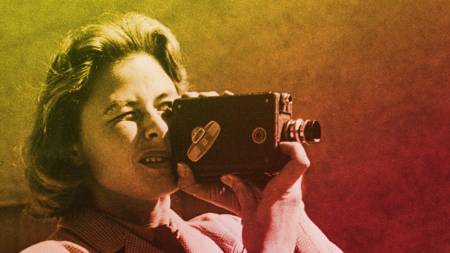
Ingrid Bergman's life reviewed in interviews and pictures
Ingrid Bergman: In Her Own Words/Jag är Ingrid is a Swedish documentary that was screened in the Cannes Classics section at the 2015 Cannes Film Festival -- where it received a special mention for L'Œil d'or award.
This is a warm picture of a great actress who had a complicated life with three husbands, and lived in Sweden, the US, Italy, France, and London. It is not just in Swedish. There are interviews in English, French, and Italian as well. Ingrid's loss of her parents when she was young may have contributed to her intentional rootlessness. And she compensated for this by scrupulously preserving her old photographs, journals, school papers, and other memorabilia, always carrying them from one new life to the next. We hear from the journals. We also get more than our fair share of what the Italians call "filmini" -- home movies, mostly showing Ingrid's young children. If you don't want to see a famous star's home movies, avoid this film.
"In Her Own Words" is not entirely entirely a good description of the documentary. In fact, Ingrid Bergman's children appear and speak very frequently, in various languages. Pia and Isabella speak only English. Roberto (the son, not the husband) speaks frequently in English, and occasionally in Italian. The gist is that while Ingrid's career and her love affairs came first and she was not a mother figure to her children, she played the role of friend to them as they grew up, and however imperfect she was as a parent, she was so charming and such fun to be with that they never felt any resentment.
New to some viewers is the fact that Ingrid had a significant affair with Robert Capa, the great photojournalist. (He died in 1954 in Vietnam, but this isn't mentioned, nor how the affair ended.)
There is some treatment of the scandal aroused, especially in the US, by Ingrid's abandonment of her marriage to Dr. Peter Lindström and taking up with Roberto Rossellini, which led to her being condemned in the US Congress and effectively banned from the US for years. But she was able to make a big comeback with the movie Anastasia in 1956, for which she won her second Academy Award, of three. Ingrid's Hollywood career with David O. Selznick, later with Hitchcock, was an immediate and great success. She was a glowing beauty and a natural on camera: she was a star. Yet her restlessness and desire for change led her to abandon Hollywood. She loved Rossellini ore than his filmmaking method; neorealism and improvisation were not her style, though she made one film with him that is mentioned, Stromboli. Mention is omitted of the four other films Rossellini made with Bergman in them: Europa '51, Viaggio in Italia, Giovanna d'Arco al rogo, and La Paura (Fear). The first Italian film is covered in the film, and also Casablanca; but all Ingrid's Hollywood career isn't covered, nor is there much detail about her life in Hollywood. The home movies only show the Benedict canyon house and the family cavorting around the pool. The limitation of home movies is so much happens away from home, if you're a big star.
The documentary goes into some detail about Ingrid's her 1978 final screen appearance, when she was seriously ill with cancer, in Ingmar Bergman's Autumn Sonata.
The kids don't want to speak ill of their mother (who played Joan of Arc so often they had to see her bur a lot), and another limitation of this film is that it offers no criticism of a life and lifestyle that must have produced enemies as well as detractors. All in all this is only a middling documentary with a preponderance of talking heads and archival footage. But its subject is too remarkable and beloved for this not to be a must-see for fans of film history.
Ingrid Bergman: In Her Own Words/Jag är Ingrid, 114 mins., debuted at Cannes; other film festivals followed. Screened for this review as one of the Documentary section films of the 2015 New York Film Festival. Showed on French TV in Aug. 2015. US theatrical release scheduled for 13 November 2015.
Last edited by Chris Knipp; 09-23-2015 at 04:16 PM.
-
ROCCO AND HIS BROTHERS (Luchino Visconti 1960) - Revivals
LUCHINO VISCONTI: ROCCO AND HIS BROTHERS/ROCCO E I SUOI FRATELLI - Revivals (1960)
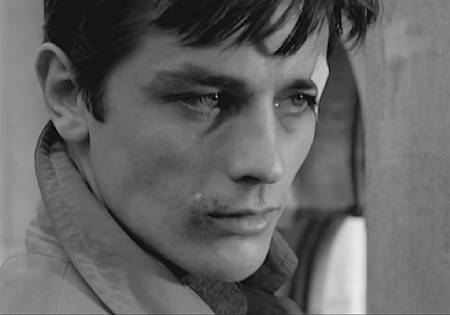
ALAIN DELON IN ROCCO AND HIS BROTHERS
Visconti's operatic epic of a southern family disintegrating in Milan arouses mixed feelings today
There are five Parondi brothers, and the film is divided into five chapters moving from eldest Vincenzo (Spiros Focás) through the lazy, badly flawed Simone (Renato Salvatori) to the saintly, self-destructively innocent Rocco (Alain Delon), to the hard working young Ciro (Max Cartier), who goes to work at the Alfa Romeo factory, to the child Luca (Rocco Vidolazzi), who gets only a brief coda. After a difficult arrival from Lucania, four of the brothers and their traditional earthy southern Italian "mamma" (the great Katina Paxinou) settle into public housing and the eldest, Vincenzo, who was already in Milan with a job and fiancee, fades from the picture: the main focus for most of the film is on the tragic conflict between Simone and Rocco which turns on their love of the prostitute, Nadia (Annie Giraudot).
Another 4K restoration from Bologna, with a couple of pieces of previously excised footage restored, this most populist, Italian, and emotional of Visconti's films is certainly worthy of a reexamination and a reassessment, which turns out to be problematic. There's no question about the scope of Visconti's vision signaled by the immersive 3-hour run-time. This was the heyday of International productions combining actors from different nations dubbed into the same language, a speciality of the Italians. Spiros Focás and Katina Paxinou were notable Greek actors; Alain Delon and Annie Giraudot, French ones. Some fine Italian thespians include Renato Salvatori and the veteran Paolo Stoppo (who plays a boxing impresario). The blending in works well, with only Giraudot never quite seeming Italian. Delon, whose skill at mime can be seen in Melville's Le Samuraï, was in his prime, and starring in an important Italian movie added to his luster; in this role he runs the whole gamut of emotions.
But the artificiality of dubbing seem more obvious today, and sometimes the lip-synching doesn't convince. Sometimes Visconti's blending of neorealism and baroque melodrama is jarring, and the whole film doesn't entirely gel. Certain scenes seem excruciatingly drawn-out, such as the long fistfight between Simone and Rocco outside the housing project, and the sordid murder by the canal. The conflict between Simone and Rocco hijacks the film. This is meant to be like a Greek tragedy, with a touch of Dostoyevsky, not to mention Vasco Pratolini and several other inspirations and sources; but that's one of the troubles -- too many sources. The narrative hardly adds up to a convincing or informative picture of the life of southern Italians who migrate north. What once was overwhelming and irresistibly moving now seems impressive, but overblown and lacking in unity.
Rocco and His Brothers/Rocco e i suoi fratelli, 180 mins., is now being released by Milestone in the US (and in Blu-ray) in a new 4K restoration on DCP by Cineteca di Bologna at L’Immagine Ritrovata laboratory in association with Titanus, TF1 Droits Audiovisuels and Martin Scorsese's The Film Foundation with restoration funding provided by Gucci and The Film Foundation. It is included in the Revivals section of the 2015 New York Film Festival, and its US theatrical release begins 9-29 October at Film Forum, New York.
Last edited by Chris Knipp; 09-22-2015 at 09:12 PM.
-
HEAVEN CAN WAIT (Ernst Lubitsch 1943) - Revivals
ERNST LUBITSCH: HEAVEN CAN WAIT (1943) - Revivals
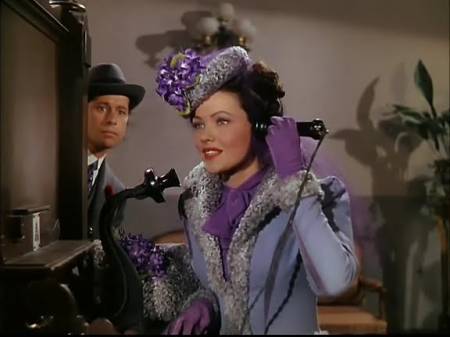
DON AMECHE AND GENE TIERNEY ABOUT TO MEET IN HEAVEN CAN WAIT
A roué on the brink of Hades reviews his life in a minor film that shows Lutitsch's light touch and charm
This is not one of Lubitsch's best films, but still shows his charm and light touch in a remastered version that does full justice to its "glorious, candy-box Technicolor. . . beautifully restored by Schawn Belston and his team at 20th Century Fox." It's a wartime triumph of the Hollywood dream machine. It's a historical fantasy about a time when the richest people in New York lived in big greystone mansions on Fifth Avenue. The framework is a consideration of whether the protagonist, the recently deceased Henry Van Cleve (an excellent Don Ameche), warrants admission to Hell by a courtly Satan (Laird Cregar). The interview leads Henry to recall his past life. There are just a few scenes at different stages, when Henry was a cocky teenager, as a young man who steals Gene Tierney from his boring cousin when they are about to get married; winning her back when after a decade she runs to her rich, boring, squabbling parents in Kansas; and Henry's attempts to remain a "player" when a (by Forties standards) superannuated sixty-year-old; and ready for extinction at seventy.
There is sharp verbal promised in the frame tale exchanges like Satan: "I presume your funeral was satisfactory." Henry: "Well, there was a lot of crying, so I believe everybody had a good time." The body of the action co-scripted by Samson Raphaelson is more romantic and kind-hearted. Also with Louis Calhern, Eugene Pallette, Marjorie Main, and Charles Coburn as Henry’s grandfather and fellow black sheep. Gloriously cinematic in an old-fashioned Hollywood studio way, this is a succession of grand interior sets created to expand the original play by Lazlo Bus-Fekete.
Henry tells his life story to Satan at the elegant gate of Hades to see if he qualifies. He turns out to have been a better guy than he realized, despite a bit of womanizing. No connection to the 1978 Warren Beatty/Buck Henry movie; no traipsing back and forth between earth and the beyond in this one. It's more a sequence of scenes that dramatize a romanticized rich class of naive Midwestern beef moguls and Fifth Avenue millionaires for whom work was a choice, not a necessity. I'm not so keen on this kind of fantasy -- there's not enough of an edge in this rote Hollywood version of it -- but I can appreciate the polished studio work and the beautifully artificial Technicolor.
Heaven Can Wait, mins., 112 mins., was originally released in the US 11 August 1943. Restored and rereleased by Twentieth Century Fox in collaboration with the Academy Film Archive and The Film Foundation. Screened for this review as part of the 2015 New York Film Festival where it was presented as part of the Revivals section.
Last edited by Chris Knipp; 09-23-2015 at 06:52 PM.
-
MICROBE AND GASOLINE (Michel Gondry 2015)
MICHEL GONDRY: MICROBE AND GASOLINE (2015)
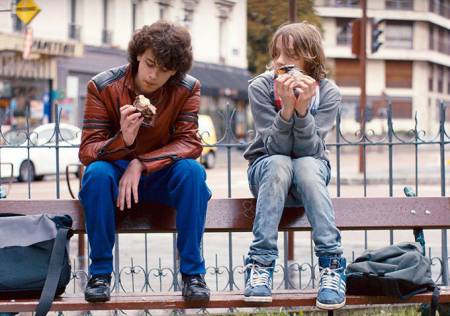
THÉOPHILE PAQUET AND ANGE DARGENT IN MICROBE AND GASOLINE
French teen boy road trip à la Gondry
Burned by the disaster of his over-produced Boris Vian adaptation Mood Indigo/L'Écume des jours (R-V 2014), or just wanting a change of pace, the DIY-gadget-mad French filmmaker Michel Gondry turns in his new film, Microbe et Gasoil,to a simple and intimate tale of two outcast, creative lyçée boys in Versailles who go on a highly original summer road trip. They're Danièl (Ange Dargent), whose over-loving eco-nut mom (Audrey Tautou) is a bit depressive, and Théo (Théophile Baquet), with a mean, unlikeable junk/antique dealer dad and an overweight mom whose health is precarious. Danièl is called "Microbe" because he's slight, and his long blond hair gets him mistaken for a girl. Théo is called "Gasoil" because his tinkering leads him to have a smell of gasoline about him. Danièl is an excellent artist who's so good he gets a gallery show (nobody comes, though, except Théo). He has painted many impressions of his brother, who sleeps in the same room and is a would-be punk musician. Théo has an older brother who's in the military.
You can see where things are going when Danièl sees his bike, equipped with a variety of sound effect gadgets. Théo finds an outboard motor and supervises their building of a strange auto run by it. They can't get a license for it, so they build a wood shack on top of it so it can pass as a cabin by the road if authorities come by. They don't tell their parents where they're going, of course.
This setup allows Gondry to lightheartedly indulge his penchant for handmade gadgetry (Les Inrocks calls the film "bricoludique"). But if for a while their makeshift vehicle is at the center of the boy's lives, the main focus is their rapid-fire, slangy conversation and the "ado" things they talk about -- girls, masturbation, courage, and philosophical issues Théo's isolation has caused him to ponder. There is something wackily analytical and French about these sometimes searching and witty chats. There is the girl called Laura (Diane Besnier) who Danièl falls for, who seems unattainable, but in the end turns out to be pining for him.
Along the way they have several adventures. They're kidnapped by a lonely couple "abandoned" by their own kids. Danièl has a tricky encounter with an oriental massage parlor where he tries to get his girly hair cut off. The boys' vehicle is seriously damaged when it's mistaken for part of a gypsy encampment that's raided in the Morvan. They lose all of it when Théo "speed tunes" the engine and it can't be stopped. When they're back in Versailles they're separated: Théo's mom has died and his dad sends him off to boarding school in Vincennes, where his older brother lives.
All this is merely a rough structure to make possible the dialogue between the two boys. The chemistry between the two young actors is palpable. This return to simplicity for Gondry is akin to his earlier straightforward films, the family portrait The Thorn in the Heart and his Bronx bus ride -- another example of his ability to tune in to young people, The We and the I. It may be true that this very French, very low-keyed road trip coming-of-ager will be a hard sell in the Anglophone world, as Peter Debruge says in his sympathetic Variety review. But it deserves a special place in the genre for its charm and specificity. This is a movie full of little offhand details so it would reveal another layer on further viewings. Gondry who rarely (well, never) has found a perfect collaborator for his surreal fantasies like Charlie Kaufman in Eternal Sunshine of the Spotless Mind, here with his own personal invention quietly achieves one of his best and most intimate works.
Microbe and Gasoline/Microbe et Gasoil, 103 mins., "Quietly released in France after being slighted by the festival circuit" (Debruge) 8 July 2015, it received raves from French critics (AlloCiné press rating 4.0). Screened for this review as part of the New York Film Festival, where the film's US premiere was set for 4 October 2015. US theatrical release begins 1 July 2016. (Northern Califoronia 15 July.)
Last edited by Chris Knipp; 06-27-2016 at 02:55 PM.
-
IN THE SHADOW OF WOMEN/L'OMBE DES FEMMES (Philippe Garrel 2015)
PHILIPPE GARREL: IN THE SHADOW OF WOMEN/L'OMBRE DES FEMMES (2015)
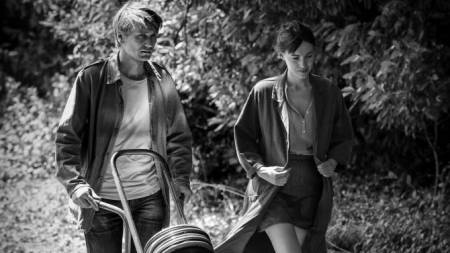
STANISLAS MERHAR AND LENA PAUGAM IN L'OMBRE DES FEMMES
Garrel offers a new twist on his favorite theme, but with what seems a flat follow-up
A memorable experience of my first New York Film Festival, in 2005, was Philippe Garrel's dreamy black and white almost three-hour epic about the aftermath of 1968, Les amants réguliers, Regular Lovers, starring his glamorous son Louis, Clotilde Hesme, and others. There is magic in this long, meandering film, which is a far more authentic picture of those days than Bertolucci's glamorous candy-box depiction of it in The Dreamers (2003), which first brought Louis (then 19) to wide attention. You either love Louis or hate him, it seems; I've chosen to love him, and I've pursued the dream his father offers in Regular Lovers ever since. In 2008, also at Lincoln Center, as part of Film Comment Selects I saw Garrel's 1991 J'entends plus la guitare (I no longer hear the guitar), which takes us back closer to the autobiographical material that feeds all his work. Louis was just a boy of eight then, though his father filmed him as a boy. The next year FCS showed the 2008 Garrel film, starring Louis, as another suicidal artist (in Regular Lovers he committed suicide as a poet abandoned by his girlfriend). It's called La frontière de l'aube (The Frontier of Dawn), and typically it's in gorgeous rich black and white, but it's unmemorable. I had to see the 2011 Un été brûlant (A Burning Hot Summer) on my own in Paris, in an obscure cinema, for obvious reasons. In color, set partly in Italy, inexplicably costarring Monica Bellucci with Louis, suicidal as usual, this time a bad painter.
Hope was provided by the 2013 La jalousie (Jealousy), starring Louis, included not without reason in that year's New York Film Festival. It's a modest and concisely edited treatment of the named theme. Philippe Garrel returns to it and to the same economical style (and usual lush black and white) in this year's L'ombre des femmes, a third Garrel père main selection of the New York Film Festival, and a worthy one, but also a bit of a disappointment -- or is it just so concise it requires re-watching? The justification of returning to the theme and the method (with son Louis present only as a Nouvelle Vague-style voice-over narrator, which he does in an elegantly detached manner) is that it does offer a sharp new twist in a screenplay written by the great Jean-Claude Carrière, who collaborated notably with Buñuel. Pierre (Stanislas Merhar)and Manon (Clotilde Courau) are a married couple, working together on a documentary about a French resistance fighter (Jean Pommier). Pierre starts an affair with a PhD candidate he meets at a film library, Elizabeth (Lena Paugam) without Manon's knowing it; Elizabeth is curious and spies on the couple to see what her lover's wife looks like -- he has confessed right off that he's married.
Then, by sheer chance, Pierre's masculine superiority is neatly undercut when Elizabeth later spots Manon in a café near the Grands Boulevards métro -- with another man (Mounir Margoum). Eventually what goes around comes around, and the fascination of In the Shadow of Women (odd title, come to think of it) is that while it focuses on Pierre's disdainful, inconsiderate behavior toward both women, the overall effect of the story is to shift from Garrel's usual male-centric point of view. No cell phones or internet or other modern trash here, and no subplots or secondary characters, other than a somewhat annoying - but not funny -- mother (Antoinette Moya), who turns up in cafés and offers advice. And somehow this simplicity makes Garrle's sensiblity seem feminine. When the second revelation comes, there's a bat-squeak of classic French cynicism and farce and female revenge à la {Les Liaisons dengereuses[/i] -- which, however, gets lost in the absurdly feel-good ending. I'm still sorting this out; it may be quite as good as Jealousy; but at the moment it feels like a film that promises more than it delivers. But the same economy has been maintained; in fact this is four minutes shorter than La jalousie. Festival reviews have been good (Metacritic 75%); the French critics loved it (AlloCiné press rating 4.1--a level rarely achieved by a film d'auteur).
In the Shadow of Women/L'Ombre des femmes, 73 mins., debuted at Cannes May 2015 with a quick, well-received French theatrical release (27 May 2015; AlloCiné press rating 4.0); eight festivals are listed on IMDb, including New York, where it was screened for this review. US theatrical release 15 Jan. 2016 Lincoln Center and IFC Center NYC.
Last edited by Chris Knipp; 12-07-2015 at 03:27 PM.
-
EXPERIMENTER (Michael Almereyda 2015)
MICHAEL ALMEREYDA: EXPERIMENTER (2015)
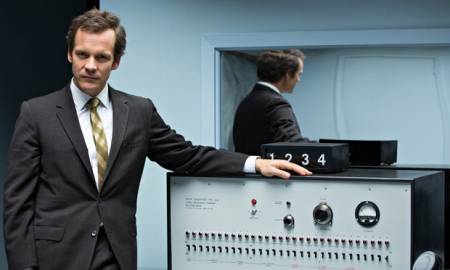
PETER SARSGAARD IN THE EXPERIMENTER
Almereyda's stylized presentation of Milgrim seems inevitable, but not brilliant
Michael Almereyda’s portrait of Stanley Milgram and his "obedience" tests invites immediate comparison with Kyle Patrick Alvarez's similarly themed recent movie Stanford Prison Experiment. Everyone prefers Almereyda's film, it would seem, because it's more stylish. I was disappointed in Experimenter and suggest rethinking this judgment. Both Milgrim and Dr. Philip Zimbardo carried out experiments, or simulations, that were clearly abusive to the volunteers and arguably unethical, and both remained lastingly famous and included in psychology textbooks for their landmark efforts. Both troublingly reflect how group psychology can bring ordinary people to do Eichmann-like or Abu Ghraib-like things.
The difference between the two films comes from the nature of the two experiments. Milgrim's isn't very interesting, and calls for jazzing up. He induced volunteer "teachers" to think they were applying progressively more severe and painful electric shocks to a heard but unseen "student." This behavior is compared to Eichmann in the film -- tried in Israel during Milgrim's time. The "obedience study" was repeated over and over with simple variations. It's shocking in its implications, but there's not much to watch. Though Almereyda might have examined it more minutely, he perhaps wisely chooses not to.
The Stanford study involved two teams of young male volunteers thrown together in a mock-up "prison" location, separately assigned the roles of "prisoners" and "guards." This was meant to go on for several weeks but was ended in a few days because it turned so nasty. The Stanford film simply recreates this event and the experimenters' reaction to it -- because it's an event rich in a variety of incidents that makes good theater. There's more to it as an event than Milgrim's setup. Alvarez assembled some of the more interesting young male movie actors of the moment for his recreation, plus Billy Crudup as the somewhat creepy and dishonest Zimbardo.
Almereyda is dealing with a deceptively simple fake setup. The "victim," the "student," is someone Milgrim has hired (the actor looks like Philip Seymour Hoffman: what if there had been more interesting actors besides Sarsgaard involved?). The real victim is the volunteer "teacher" who is induced to violate his or her own morality in giving, they think, electric shocks to someone they hear protesting and crying out in pain. But this volunteer just sits there. It's not very cinematic. Hence, Almeyreda's movie, which ingeniously treats everything from the outset as make-believe, and gives that quality troublingly pervasive. Backgrounds of interiors and exteriors are just giant black-and-grey photographs. Unlike the overwrought Zimbardo-Crudup, Milgrim-Sarsgaard seems more like an articulate blank, whose detachment is further enacted by having him frequently address the camera. This self-reflective approach still seems original, fifty years after the time when it seemed so in fiction.
Milgrim's career was more tricky, because he was banished from the Ivy League to CUNY, while Zimbardo got to stay at Stanford for life. But the trouble with making Experimenter into a biopic is that Milgrim, like Zimbardo, essentially lived off his one landmark experiment for the rest of his (less long) life. It is not clear to me how we are meant to take his relationship with his doggedly supportive wife (a colorless Winona Ryder). Experimenter skates along, taking Milgrim from one place and career situation to another, embroidering with information about the implications of the "obedience studies." Despite its review of Milgrim's post-obedience career and life, the rest of a movie is essentially just a review of the implications of what happens in the first few minutes. The one ironic moment comes when Milgrim's study is dramatized and distorted for television. What we can say is that the 90-minute Experimenter is more economical than the 122-minute Prison Experiment. Perhaps Milgrim's basic work has more scientific clarity than Zimbardo's setup. Sarsgaard is an interesting actor, who's suitably enigmatic here. His enunciation at times seemed unclear.
Perhaps I'm missing something in failing to see the festival blurb's claim that Experimenter depicts "the bohemian-tinged academic world of the 1960s through the 1980s with an economy that Stanley Kubrick might have envied." Experimenter may be clever, but Stanford Prison Experiment is a more involving watch. Both are disturbing, interesting, and instructive. Neither is a great movie.
Experimenter, 90 mins., debuted at Sundance; over a dozen other festivals. Screened for this review as part of the New York Film Festival. US theatrical release 16 October 2015. (Metacritic rating 81%/)
Last edited by Chris Knipp; 10-16-2015 at 02:36 PM.
-
NO HOME MOVIE (115m) - Chantal Ackerman 2015)
CHANTAL ACKERMAN: NO HOME MOVIE (2015)
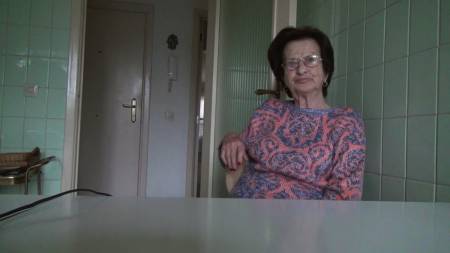
CHANTAL ACKERMAN'S MOTHER NATALIA IN NO HOME MOVIE
Economy or emptiness?
When one considers that the topic of this film, Chantal Ackerman's mother Natalia, nearing the end of her life, is at the center of her large multi-media body of work, it is disappointing to find ourselves spending most of nearly two hours looking at the interior of a comfortable Brussels apartment. Occasionally here are brief conversations between Chantal and her mother, in person and by Skype. The Skype ones are the worst, but also are a touching indication of how interactions with the elderly can be reduced to repetitious platitudes when both speakers would rather be saying important, significant things.
Ackerman's mother was a Polish survivor of Auschwitz who married and started a family in Brussels. The filmmaker follows her usual observational style, which means that the camera sits there. Sometimes people move, and sometimes they don't. Several long interludes of the camera sitting there watching a windy desert landscape are not explained. They may be taken as an objective correlative of her mother's hard early life. What we learn explicitly from conversation about Ackerman's mother is basic.
Taking a hint from Peter Debruge's Locarno review for Variety, we can say this film makes frequent references to her, Chantal's, own rootlessness, while at the same time reaffirming her closeness to her mother, and incidentally Natalia's closeness to her own mother. Debruge says (but this film does not explicitly state) that Chantal no longer considers Brussels her home; and at one point she is Skyping Natalia from Oklahoma.
It reminds me of my other father in his last days that Natalia at one point says Chantal never talks to her about the interesting things she is doing. Indeed Chantal seems confined to simplistic "interview" type questions and affectionate banalities. This, the material of family footage everywhere, is touching but not interesting.
What of the title? It may be in a similar category with Panahi's This Is Not a Film. This film may be "formally demanding" (Debruge), but it is pretty much a home movie, if by a famous avant-gardist filmmaker studiously eschewing charm or conventional polish. But Debruge reports that this film "was booed by some at its press screening in Locarno, where critics fully expect the lineup to test their limits."
No Home Movie, 115 mins., debuted 10 August 2015 at Locarno; also shown at Toronto, and at the New York Film Festival; it was screened as part of the latter for this review.
Last edited by Chris Knipp; 09-24-2015 at 09:14 PM.
 Posting Permissions
Posting Permissions
- You may not post new threads
- You may not post replies
- You may not post attachments
- You may not edit your posts
-
Forum Rules





 Reply With Quote
Reply With Quote






Bookmarks